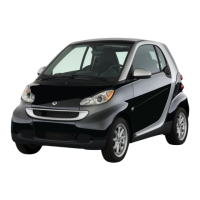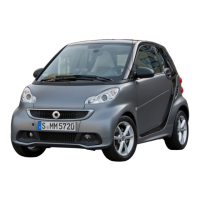
Do you have a question about the SMART Series 451 and is the answer not in the manual?
| Brand | SMART |
|---|---|
| Model | Series 451 |
| Category | Automobile |
| Language | English |
Details loads, weights, and other performance data for both models.
Explains the vehicle's scheduled maintenance intervals and philosophy.
Outlines the active and passive safety systems integrated into the vehicle.
General overview of the electrical system and its main components like battery and starter.
Illustrates the overall network of control units and their locations.
Shows the bus network diagram connecting various control units.
Explains the diagnostic process using the data link connector and diagnostic tester.
Explains SAM unit communication protocols and integrated relays.
Introduces the 3-cylinder gasoline engine (M132) and its specifications.
Provides detailed specifications for the M132 engine, including output and dimensions.
Describes the ME motor electronics system for fuel injection and ignition.
Details the small and large coolant circuits and fan operation.
Explains the non-return fuel system, fuel pressure, and fuel tank capacity.
Outlines the multi-stage process for testing fuel system leaks.
Details the secondary air injection system's function in reducing emissions after a cold start.
Introduces the 2nd generation 5-speed AMT and its advantages.
Provides detailed technical data for the AMT 2 transmission, including torque and weight.
Explains the components and operation of the gear shifting mechanism.
Describes the Borg-Warner synchronization system used in forward gears.
Explains the function of the transmission rpm sensor for monitoring clutch and gear engagement.
Explains the function and inputs of the AMT control unit.
Details the function of the control unit that records driver shift requests.
Explains the mechanical park pawl that prevents vehicle rolling.
Describes the single-plate dry clutch and its overload warning function.
Explains the TPM system's function in monitoring tire pressure for safety.
Explains the function of the service and parking brake systems.
Describes the Electronic Stability Program and its integrated functions like ABS and ASR.
Explains ESP's role in minimizing oversteer/understeer via brake intervention.
Introduces the optional Electric Power Steering system and its ratio.
Explains the function of the instrument cluster in displaying vehicle information and warnings.
Outlines the different roof variants available for the smart fortwo coupé and cabrio.
Explains the central locking system's functions, including remote and manual operation.
Details the anti-theft alarm system's monitoring, activation, and deactivation.
Explains the heating system functions, blower stages, and temperature-regulated air conditioning.
Describes the concept of detachable body panels and their construction.
Explains the components and operation of the vehicle's airbag and restraint systems.
Details the bodyshell structure, including the tridion safety cell and material types.
Explains the front and rear crash management systems designed to absorb impact energy.











